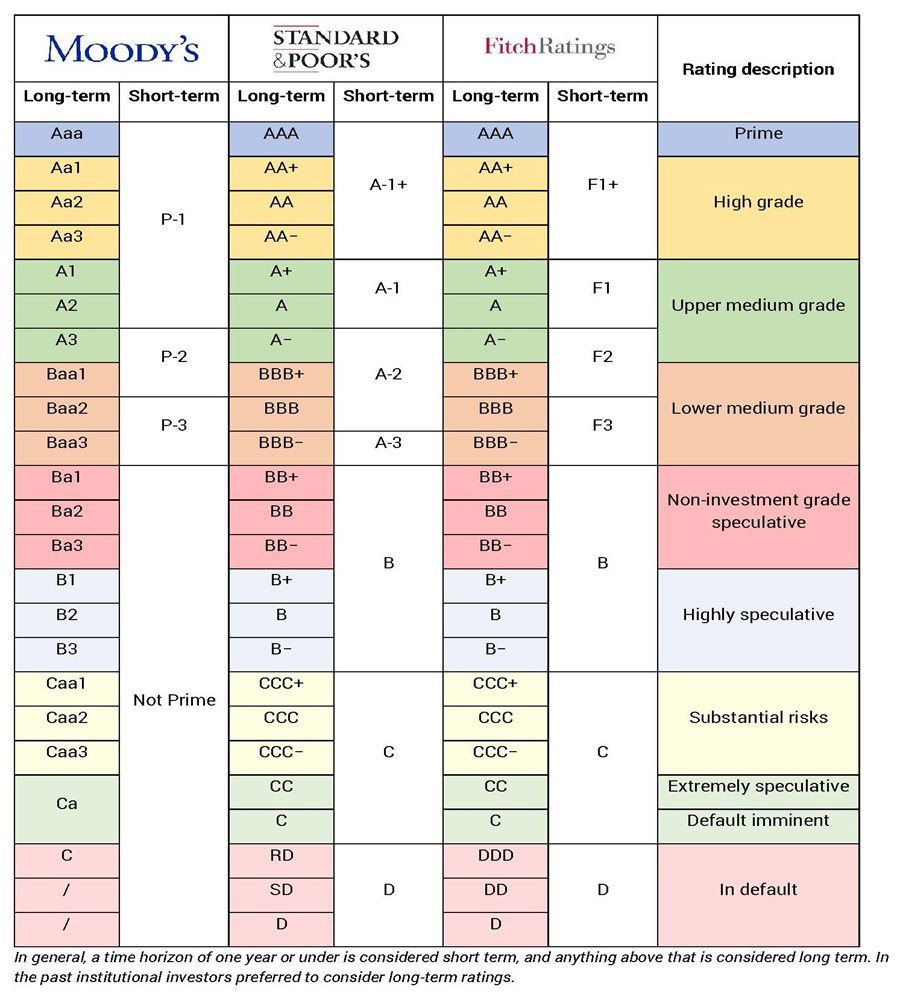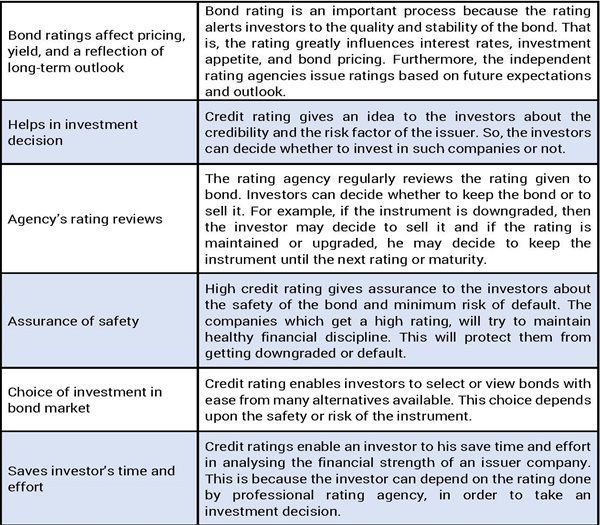
BIX ARTICLE
Why is Credit Rating Important for Bond and Sukuk?
Feb 27, 2019
|
12 min read
Featured Posts
Social Bonds Illustrative Use-Of-Proceeds Case Studies Coronavirus
Jul 06, 2020
|
2 min read
Sustainable Banking Network (SBN) Creating Green Bond Markets
Jul 06, 2020
|
2 min read
Why is Inflation Making a Big Comeback After Being Absent for Decades in the U.S.?
Mar 24, 2022
|
7 min read
SC issues Corporate Governance Strategic Priorities 2021-2023
Mar 29, 2022
|
3 min read

Recent news related to credit rating given to Malaysia by international agencies particularly Standard and Poor’s (S&P) and Moody’s have been the subject of debates and speculation about the future of Malaysia’s economy. ‘Fitch affirms Malaysia rating at "A-", outlook stable’, ‘RAM: Malaysia's sovereign ratings unaffected by Budget 2019’, ‘Moody’s changes Petronas’ ratings outlook from stable to negative’ and ‘RAM Ratings reaffirms Singapore’s gAAA(pi) ratings’ are some of the headlines that have appeared on local and international news. What is credit rating? Why does it give huge impact on a country and company’s economy and movement amongst investors and economists?
Credit ratings, as these metrics are known, are usually seen in the wider context of the country’s economic health, so it is unsurprising that after breaking such news, economists and politicians will weigh in on the implications of what it means to either be graded an “A+” or a “BBB” or even “junk”. One thing credit rating ensure is easy access to international capital markets, and favourable ratings imply low borrowing costs.
For Malaysia – where foreign ownership of government bonds is estimated around 40.7% as of end-October 2018 – positive ratings from top agencies ensure it can easily and cheaply access foreign capital needed to accomplish the country’s economic agenda. This article will give an insight to credit rating and its importance.
Definition of Credit Rating
A third-party assessment about the creditworthiness of an individual or entity that seeks – an individual, corporation, state or provincial authority, or sovereign government that want to borrow money. Its sets a prediction on their ability to pay back the debt as well as giving an implicit forecast of the likelihood of the debtor defaulting.
Definition of Bond Credit Rating
A representation of the creditworthiness of corporate or government bonds. It provides evaluations of a bond issuer’s financial strength and capacity to repay the principal and interest according to the contract.
Ratings can be assigned to short-term and long-term debt obligations as well as securities, loans, preferred stock and insurance companies. Long-term credit ratings tend to be more indicative of a country's investment surroundings and/or a company's ability to honour its debt responsibilities. For a government or company, it is sometimes easier to pay back local-currency obligations than to pay foreign-currency obligations. The ratings, therefore, assess an entity's ability to pay debts in both foreign and local currencies. A lack of foreign reserves, for example, may warrant a lower rating for those obligations a country made in foreign currency.
Ratings are not equal to or the same as buy, sell or hold recommendations. Ratings measure an entity's ability and willingness to repay debt.
Why is It Important?
- Determine the size of investor pool – When a bond moves into investment-grade ratings, it draws buyers from a much larger pool. When a bond falls into junk bond or non-investment grade ratings, it can only find financing from investors willing to invest in speculative-grade investments (a much smaller pool of investors.)
- Determine price and yield of a bond – Higher-quality bonds may trade at a premium to face value and offer yields substantially lower than bonds that are not investment-grade. Price and yield are inversely related in the bond market.
- Determine the value of the stock – Academically speaking, better bond ratings should lead to falling bond yields and higher stock prices, as they are all related in capital asset pricing models.
Benefits of credit rating to issuers
- Improves corporate image: Credit rating helps to improve the corporate image of a company. High credit rating creates confidence and trust in the minds of the investors about the company.
- Lowers cost of borrowing: Companies that have high credit rating for their debt instruments will get funds at lower costs from the market. High rating will enable the company to offer low interest rates on fixed deposits, debentures and other debt securities.
- Enlargement of investor pool: A company with high rating can get a wider audience for borrowing. It can approach financial institutions, banks, investing companies. This is because the credit ratings are easily understood not only by the financial institutions and banks, but also by the general public.
- Act as a marketing tool: Credit rating not only helps to develop a good image of the company among the investors, but also among the customers, dealers, suppliers, etc. High credit rating can act as a marketing tool to develop confidence in the minds of customers, dealer, suppliers, etc.
- Helps in growth and expansion: Credit rating enables a company to grow and expand. This is because better credit rating will enable a company to get finance easily for growth and expansion.
A sovereign credit rating is the credit rating of a sovereign entity, such as a national government. The sovereign credit rating indicates the risk level of the investing environment of a country. This rating reflects factors such as a country's economic status, transparency in the capital market, levels of public and private investment flows, foreign direct investment, foreign currency reserves, political stability, or the ability for a country's economy to remain stable despite political change.
Because it is the doorway into a country's investment atmosphere, the sovereign rating is the first thing most institutional investors will look at when deciding whether to invest money abroad. This rating gives the investor an immediate understanding of the risk level associated with investing in the country. A country with a sovereign rating will therefore get more attention than one without. In order to attract foreign money, most countries will strive to obtain a sovereign rating, and they will strive even more to reach investment grade. In most circumstances, a country's sovereign credit rating will be its upper limit of credit ratings.
Some of the developments that have been cited that can affect Malaysia’s ratings are economic reforms such as the government’s efforts to strengthen the budget, the deteriorating ringgit, and the broader pressure of the economic on commodity prices, among others.
Malaysia’s Sovereign Rating by International and Local Rating Agencies
Corporate Credit Rating
Credit ratings can address a corporation's financial instruments i.e. debt security such as a bond, but also the corporations itself. A corporate credit rating is an opinion of an independent agency regarding the likelihood that a corporation will fully meet its financial obligations as they come due. A company’s corporate credit rating indicates its relative ability to pay its creditors and gives investors an idea of how the company’s debt securities should be priced in term of yields. Corporate credit ratings are not a guarantee that a company will repay its obligations, but the overall, long-term track record of these ratings is indicative of the differences in creditworthiness among rated companies.
History of Credit Ratings Industry
Nearly all Asian developing countries now have at least one rating agency; India has five, South Korea has four credit rating agencies, Malaysia, Indonesia and Philippines each have two and Thailand so far has one credit rating agency. The importance of domestic credit rating agencies to the development of capital markets is generally accepted and well-recognized by financial communities in Asia. Key regional initiatives mean fundamentals have improved and even strengthened since the Asian financial crisis but liquidity, lack of information and insufficient quality credit and reliable credit rating all hinder investment growth (Source: Asia Bonds: Where to From Here? Hong Kong forum, 2018).
Credit rating in Malaysia
Developing the bond markets in Malaysia has become one of the most important policy issues since the financial crisis of 1997/98. The need for a credible credit rating process is to ensure the efficient functioning of the Malaysian bond market. With the growing appetite of Malaysian companies (and to some extent, governments and state enterprises) for bonds and the increasing spectrum of credits coming onto the market, independent third-party opinions will become more valuable in assisting investors in their investment decisions. In general, the Malaysian corporate bond market has seen many changes and its growth is due to the economy becoming more diversified in the private sector. Malaysia has benefited from bond markets as an important source of financing that contributes to the economic growth process.
International Rating Agency’s Long-Term and Short-Term Rating

Malaysia’s Rating Agency’s Rating Definitions and Indicators
There are currently two rating agencies in Malaysia that are approved by Securities Commission Malaysia – RAM Rating Services Berhad (RAM Ratings) and Malaysian Rating Corporation Berhad (MARC). In January 2017, the Securities Commission removed the mandatory bond rating as part of measures to liberalize the financial sector and broaden the corporate bond market.
Rating Outlook
A rating outlook is affixed to long-term ratings assigned by RAM (covers a 6- to 24-month time horizon) and MARC (typically over a one-to two-year period). The outlook – which may either be: -
The rating outlook incorporates RAM Ratings’ consideration of certain changes in circumstances, economic conditions and/or operating environments that could alter the fundamental credit quality of a rated entity or issue over a period (but with less certain immediate implications, compared to events which trigger a Rating Watch). In this regar, a rating outlook encompasses a longer time frame than a Rating Watch. As a general guide, a rating outlook covers a 6- to 24-month time horizon. A revision in rating outlook is not necessarily a precursor of a change in the rating.
Rating Indicators
Limitations of Credit Ratings
Credit rating may represent the creditworthiness of an organisation or a country’s financial strength. However, there are some limitations or boundaries which credit rating may be applied to the issuer. Credit ratings are statements of opinion and not statements of fact. They are an independent opinion of the creditworthiness of an entity or obligor either in general (an issuer rating) or with regard to a specific financial obligation (an issue rating). Rating is no guarantee for soundness of company and should not be construed as a certificate for the matching quality of the company or its management.
Investors should be aware that credit ratings focus on one aspect of investment risk – credit (or repayment) risk – and do not explicitly capture loss severity or recovery prospects such as market or liquidity risks, which may also affect the value of a security. Nor does a credit rating consider the price at which the security is offered or sold. It is also important for investors and public to understand that credit ratings are not recommendation to purchase, sell, or hold stocks or shares in an institution or particular security. Credit ratings may be used as an analytical input into, but are not a substitute for, investors’ own risk management.
Limitations of credit rating in Malaysia
MARC and RAM assign credit ratings on a national scale and not intended to be internationally comparable. The agencies provide relative measures of credit risk of entities and obligations in the context of the domestic market, as opposed to conveying specific default probabilities. They do not address any risks other than credit risk, including the liquidity of the rated security and the likelihood of a change in its market value, and the severity of loss should the obligation or issuer default.
MARC and RAM are subjected to registration and oversight program administered by the Securities Commission Malaysia (SC). These agencies shall not state or imply that the SC endorses its credit ratings or use its registration status to advertise the quality of its credit ratings.
Conclusion
The depth of the bond and sukuk market can make it difficult for investors to assess whether one company is likely to repay its debt than another. In order to simplify comparison of different bonds and sukuk, rating agencies make it their specialties to issue ratings for different bonds and sukuk (click here to read more on credit rating agencies). Bond credit ratings use a combination of letters, numbers, and symbols to indicate their relative placement on a given agency's rating scale. Letters generally indicate a broad range of ratings. In general, having more letters in the rating is generally better than fewer letters, and being earlier in the alphabet indicates higher quality.
Ratings are not a perfect indicator of what will happen with particular bonds or securities, and ratings haven't always worked in the way they were intended. Nevertheless, as a measure of relative strength, ratings are a good starting point for research on a company's debt.
A credit rating is a useful tool not only for the investor, but also for the entities looking for investors. An investment-grade rating can put a security, company or country on the global radar, attracting foreign money and boosting a nation's economy. Indeed, for emerging market economies, the credit rating is key to showing their worthiness of money from foreign investors. And because the credit rating acts to facilitate investments, many countries and companies will strive to maintain and improve their ratings, hence ensuring a stable political environment and a more transparent capital market.
However, it is best to keep in mind that credit ratings are not recommendation for investors to purchase, sell, or hold stocks or shares in an institution or particular security. They are an opinion or assessment made by regulated agencies and its ability to assign and maintain objective and predictive ratings is subject to the availability of sufficient timely, accurate and complete public and/or non-public information.
For more information on Malaysia’s bond and sukuk issuances and the rating assigned, use BIX SEARCH tools in BIX Malaysia using steps below:
- Click the BIX SEARCH function on the front page
- Filter the Rating to preferred rating by chosen rating agency & click on preferred issuance
- Under BOND+SUKUK INFORMATION, you can check the issuance’s rating
- You can also click RATING MOVEMENTS to check issuer’s historical rating movement
Disclaimer
This report has been prepared and issued by Bond and Sukuk Information Platform Sdn Bhd (“the Company”). The information provided in this report is of a general nature and has been prepared for information purposes only. It is not intended to constitute research or as advice for any investor. The information in this report is not and should not be construed or considered as an offer, recommendation or solicitation for investments. Investors are advised to make their own independent evaluation of the information contained in this report, consider their own individual investment objectives, financial situation and particular needs and should seek appropriate personalised financial advice from a qualified professional to suit individual circumstances and risk profile.
The information contained in this report is prepared from data believed to be correct and reliable at the time of issuance of this report. While every effort is made to ensure the information is up-to-date and correct, the Company does not make any guarantee, representation or warranty, express or implied, as to the adequacy, accuracy, completeness, reliability or fairness of any such information contained in this report and accordingly, neither the Company nor any of its affiliates nor its related persons shall not be liable in any manner whatsoever for any consequences (including but not limited to any direct, indirect or consequential losses, loss of profits and damages) of any reliance thereon or usage thereof.
YOU MAY ALSO LIKE
ARTICLE
Dec 01, 2025
|
4 min read
ARTICLE
Nov 04, 2025
|
4 min read
ARTICLE
Oct 16, 2025
|
5 min read
ARTICLE
Sep 03, 2025
|
4 min read



